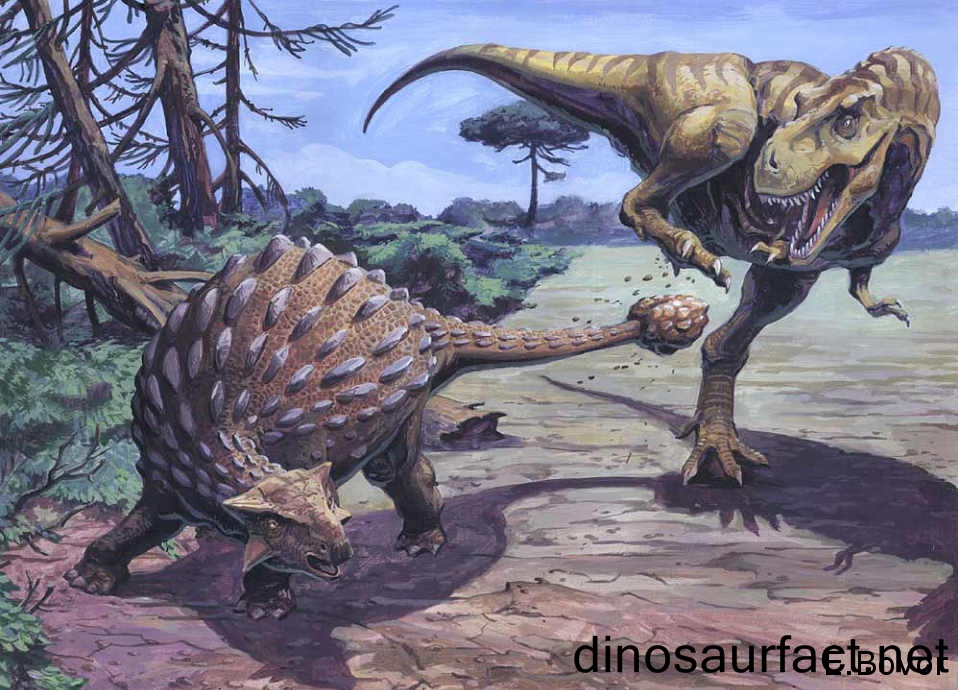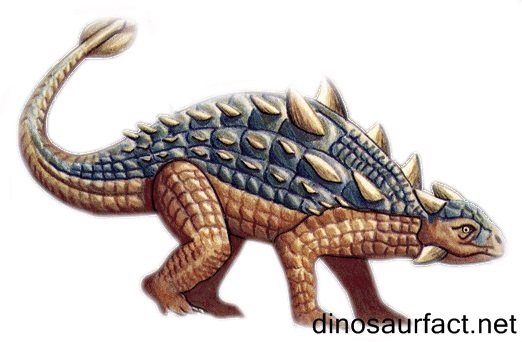 Click to visit the previous dinosaur bio
Click to visit the previous dinosaur bio
 |
|
 |
|
Kingdom: Animalia
Phylum: Chordata
SuperOrder: Dinosauria
Order: Ornithischia
SubOrder: Ankylosauria
Family: Ankylosauridae
Genus: Ankylosaurus
 |
|
 |
|
 |
|

The Ankylosaurus is considered the quintessential armored dinosaur ever since its discovery in the year 1906. It was one first ankylosaurs every to be discovered and hence it garnered a lot of media attention. Although many other ankylosaurs are much better defined, the Ankylosaurus far surpasses them in popularity. It is also the largest known ankylosaurid, which adds to its appeal.
This reptile was existent on the earth about 70 to 62 million years ago. This time period lies in the final Maastrichtian age of the Cretaceous period. It is possible that it lived right up to the Cretaceous Paleogene extinction event and was exterminated due to it. Its fossils were found in the Wyoming, America and also Alberta, Canada.
The most famous contemporary of the Ankylosaurus was the Tyrannosaurus rex. One of the T. rex fossils in Wyoming had about 75 osteoderms around it, which resembled those of the Ankylosaurus. Thus, it is possible that the two fought each other in mortal combat.
The Ankylosaurus was a plant eating dinosaur. The largest specimen of the dinosaur was about 20 feet in length. It possibly weighed around 3000 to 4000 kilograms.
Nomenclature
The Ankylosaurus was christened by paleontologist Barnum Brown.
The name Ankylosaurus is composed to separate terms. The suffix ‘ankylo’ is derived from the Greek word ‘ankulos’ which means ‘curved’. But Brown likely used it for its medical connotation; ‘ankylo’ is used in medical terms to denote ‘fused’. The term ‘ankylosis’ indicates stiffened joints due to bone adhesions. The suffix ‘saurus’ is derived from the Greek word ‘sauros’ which means ‘lizard’ in English. Thus, the word Ankylosaurus roughly translates to ‘stiffened; or ‘hardened’ lizard.
The specific name A. magniventris is also a combination of two words. ‘Magnus’ and ‘venter’ are Latin words for ‘large’ and ‘stomach’. This term was chosen due to the fact that the Ankylosaurus had a very stout belly.
Discovery of fossils
- The fossils of the Ankylosaurus were discovered by a team lead by scientist Barnum Brown in the Hell Creek Formation in Montana. This was the holotype specimen and consisted of the top of the skull, a few dorsal vertebrae, ribs, and parts of the pectoral girdle. The armored scales were also included in this specimen. This was in the year 1906.
- In the year 1900, Brown had found a lot of osteoderms along with the specimen of a large theropod, in the Lance Formation of Wyoming. This theropod turned out to be the T. rex and the ossified scales had almost immaculately matched those newer ankylosaur specimen.
- In 1910, Brown was visiting Alberta, Canada on an archeological expedition and found a few more bones that resembled the Ankylosaurus. These included a complete skull, some ribs, fragments of the limbs and most importantly, the tail club. These were found in the Scollard Formation.
- 1947 revealed another skull from the Scollard Formation. This was the biggest Ankylosaurus to ever be found and it was discovered by Charles Stenberg.
Current location of fossils
All the remains unearthed by Barnum Brown are currently preserved in the American Museum of Natural History in New York. Those discovered by Stenberg are housed in the Canadian Museum of Nature.
Classification
The Ankylosaurus is classified under order Ornithischia, suborder Ankylosauria, family Ankylosauridae and subfamily Ankylosaurinae. The taxon Ankylosauria consists of scaled dinosaurs and includes the nodosaurids and the polacanthids. The Ankylosaurus is considered the type genus for family Ankylosauridae only.
The osteoderms
The term ‘osteoderm’ directly translates to ‘bones in the skin’. They are ossified plates of the exoskeleton and acted as a defense mechanism for the Ankylosaurus. It had such plates arranged all over its neck, back and pelvic region. Smaller plates were arranged across its legs and underbelly. The space in between the plates was covered with nodular osteoderms, thus making the armor of the Ankylosaurus almost impenetrable.
The skull of the Ankylosaurus had specialized scales that formed horn like projections at its base.
The tail club
Apart from its scales, the most distinctive feature of the Ankylosaurus is its tail club. It was formed by the fusion of several osteoderms. These osteoderms were fused with the last few coccygeal vertebrae of the dinosaur. It was also supported by strong tendons and scientists posit that it could generate enough force cause substantial soft tissue damage as well as break bones when swung, similar to a wrecking ball.
It cannot be said for sure whether this structure was indeed an offensive and defensive weapon, but most paleontologist believe so.
The physical characteristics
- The Ankylosaurus is the largest known ankylosaurid. It adult length from snout to tail tip was about 6 to 6.5 meters. The girth of its widest part, its stomach was about 1.5 meters and its tallest portion of its body, its hips, cleared the ground by about 1.7 meters.
- The skull of the Ankylosaurus was about 25 inches long and 29 inches wide.
- The dinosaur had very small teeth. This indicated it did not chew its food much.
- The forelegs and hind legs of this dinosaur were almost similar in length. Although no phalanges were discovered that could be attributed to the Ankylosaurus, scientists believe it had five fingers and toes like other ankylosaurids.
- The tail of this dinosaur was long, and was strong enough to bear the tail club.
- Its armor gave it a highly spiny appearance.
Habits and habitat
The Ankylosaurus was an herbivorous, terrestrial dinosaur. It walked very slowly and most likely could not rum fast. Its body was adapted in such a way that its head was always close to the ground. The small teeth and the large belly of the Ankylosaurus indicated that it had an elaborate stomach meant to digest tough greens, much like that of modern cattle and horses. It likely derived its nourishment from small shrubs, ferns and cycads.
The habitat of the Ankylosaurus consisted for woodlands, plains and grasslands that received abundant rainfall.
Related and coexisting species
The Ankylosaurus is closely related to the Euoplocephalus. It coexisted with well-known dinosaur species such as the Triceratops and Tyrannosaurus. The other species that it lived alongside were the Torosaurus, Edmontonia, Edmontosaurus, Troodon, etc.
The final notes
The Ankylosaurus is the most popular and celebrated armored dinosaur. The Godzilla movies portrayed it as the ancestor to a mutated monster. There is fossil evidence that it may have warded off a T. rex attack. Yet the information available about this magnificent dinosaur is incomplete. A complete skeleton has never been ascribed to the Ankylosaurus.
Index
Extinct Profiles
 Triassic Dinosaurs
Triassic Dinosaurs Jurassic Dinosaurs
Jurassic Dinosaurs Cretaceous Dinosaurs
Cretaceous Dinosaurs Pterosaurs
Pterosaurs Marine Reptiles
Marine Reptiles Dinosaur Extinction
Dinosaur Extinction